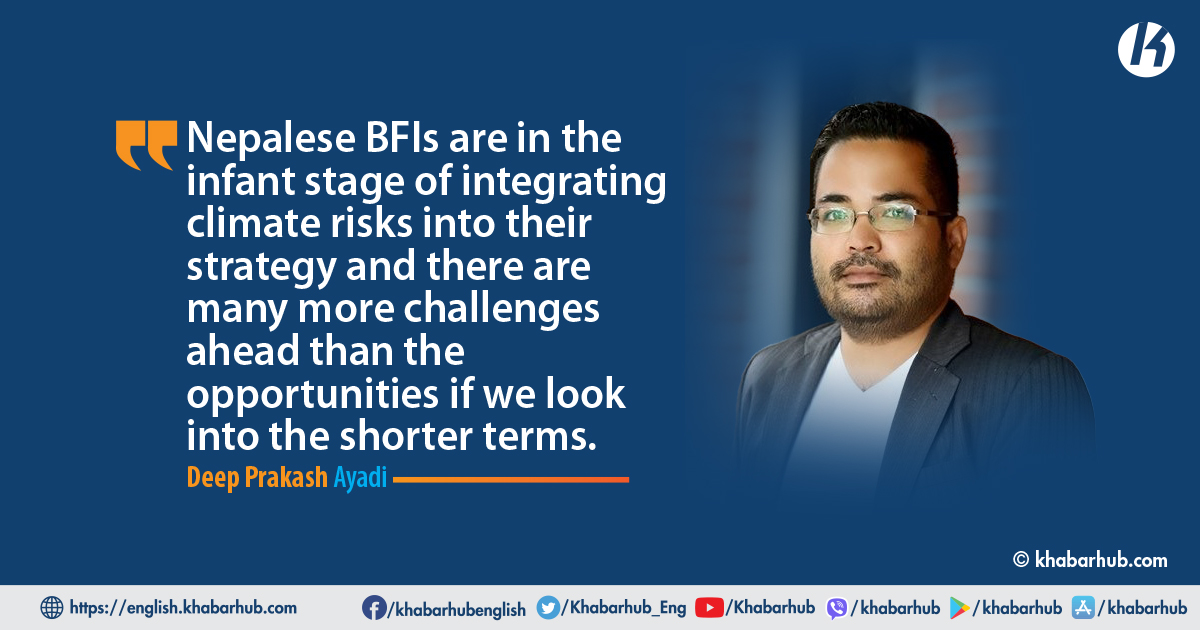It is indeed a proven fact that climate change has direct or indirect impacts on Banks and Financial Institutions (BFIs) and the actions of BFIs also contribute to climate change.
Recognizing this Nepalese BFIs along with the central bank, Nepal Rastra Bank has committed to working towards addressing climate risk through appropriate actions.
However, there is a need for these BFIs to further integrate climate risk into their strategies to make it comprehensive, applicable, and relevant to their operations. Integrating climate risk into BFIs strategies presents both challenges and opportunities for Nepalese BFIs.
Challenges
While many of the BFIs have already started to include climate risks in their processes, the main challenges are the knowledge gap among finance professionals.
BFIs need to integrate climate risks into their risk management frameworks and scenario analysis. This involves understanding the physical risks of climate change and the transition risks associated with policy changes, technological advancements, and shifting market preferences.
Likewise, while there is an increasing need for green financing and sustainable investments, BFIs may have difficulty identifying and evaluating potential green investment possibilities.
A lack of clarity about the financial rewards, market demand, and scalability of green projects can stymie capital deployment for addressing climate risks. Hence, finance professionals need to understand different economic sectors and their relation with climate change.
Similarly, how climate change policies can influence these economic sectors is important. This understanding helps identify climate-related risks, such as physical risks and transitional risks.
By taking a climate risk lens at their portfolios and transactions, BFIs can identify opportunities for new investments that were previously overlooked.
With the complexity of climate science, the BFIs employees do not understand it fully. Strong expertise and knowledge of climate issues will be essential as banks confront the enormous challenges posed by climate change.
Many BFIs currently perceive climate risk integration as a blind spot within their operations. Consequently, the prospect of recruiting new human resources with the requisite expertise may appear daunting, necessitating the development of a comprehensive strategy to address these gaps.
This strategy may involve either providing training to existing personnel or engaging the services of external consultants.
However, the latter option can be costly and may not align seamlessly with the working hours and requirements of the institution.
Therefore, prioritizing the capacity building of staff emerges as the primary and indispensable initial step towards the successful integration of climate risk considerations into the BFI’s overall business framework.
Capacity building for BFIs is crucial to address the knowledge gap and enable effective integration of climate-related risks into their operations.
This process encompasses various aspects, ranging from general sensitizations to specialized training specifically focused on climate-related risks.
By providing comprehensive training, BFIs can equip their employees with the necessary knowledge and skills required to navigate the complexities of climate risk.
Also, it increases the ability to manage climate risks and seize opportunities arising from the transition to a low-carbon economy. But such capacity-building activities should be tailored to the organization’s needs and project portfolio.
The risk management team, loan officers, project staff, investment analysts, and other relevant staff can have specific training for their job responsibilities.
BFIs have a wide range of investment sectors. It is very challenging to understand how every sector interacts with climate indicators as well as is affected by climate risk.
Understanding each sector is challenging for BFIs. Also, with the new sectors emerging it is outrageously challenging. The diversity of sectors, such as hydropower, agriculture, real estate, and many more, that each sector has unique characteristics, vulnerabilities, and opportunities regarding climate risk.
BFIs must stay updated on evolving climate change-related regulations to manage climate risks. The emergence of new sectors and industries further adds to the complexity.
BFIs need to continually monitor these emerging sectors, such as electric vehicles, renewable energy, and sustainable waste management to make informed investment decisions.
Opportunities
The BFIs may have numerous opportunities while integrating climate risk into BFIs strategy. It is a proven fact that BFIs are at risk of climate change through their lending process and many other activities.
This reality underscores the paramount importance to mitigate all these risks to secure their investment and return on their investment.
BFIs have investments across sectors such as hydropower, agriculture, and real estate. All these sectors are highly vulnerable to climate change.
They gain a reputation for being proactive in addressing climate change, which enhances their standing in the eyes of customers, investors, and the general public. This positive reputation can lead to increased trust, attracting stakeholders who value sustainability practices.
These sectors experience disruptions and challenges throughout their supply chains, intensifying the risks faced by BFIs.
By mitigating all these risks, BFIs reduce the financial and reputational risks, at the same time increasing the climate resilience of the project.
This ensures the preservation of their investment portfolios, shields them from potential losses, enhances their standing in the market, and positions them to thrive in an increasingly climate-impacted world.
By taking a climate risk lens at their portfolios and transactions, BFIs can identify opportunities for new investments that were previously overlooked.
They can explore investment in renewable energies, climate-smart agriculture, sustainable waste management, and resilient infrastructure that contribute to climate change adaptation and mitigation.
Furthermore, BFIs can tap into the growing demand for climate-friendly products and services. The global demand for such products is increasing and BFIs can provide financial support to businesses to move on that path. This presents an opportunity for BFIs to enter emerging markets.
To support their climate-related operations, BFIs can also issue Green Bonds. These bonds attract capital from investors specifically interested in funding climate-friendly projects.
By accessing this capital, BFIs can expand their capacity to finance climate-related investments and demonstrate their commitment to addressing climate change.
Integrating climate risk into a BFIs strategy provides opportunities for reputation and brand enhancement by actively addressing climate change and demonstrating a commitment to sustainability. BFIs that incorporate climate risk into their strategy are seen as sustainably responsible institutions.
Nepalese BFIs are in the infant stage of integrating climate risks into their strategy and there are many more challenges ahead than the opportunities if we look into the shorter terms.
They gain a reputation for being proactive in addressing climate change, which enhances their standing in the eyes of customers, investors, and the general public. This positive reputation can lead to increased trust, attracting stakeholders who value sustainability practices.
By demonstrating a genuine commitment to sustainability, BFIs can set themselves apart as leaders in the industry.
This differentiation can attract customers and investors who prioritize sustainability and seek out BFIs that align with their values.
In the end, climate change is a new subject among Nepalese BFIs. It possesses challenges and opportunities at the same time.
Lack of knowledge on climate risk among the bank staff, and capacity to handle the overall assessment process lies ahead. Diversification of sectors adds challenges to that.
But by handing it they can have an opportunity. By integrating climate risk into the BFI strategy, they can reduce the physical and transitional risks, increase the brand value, and tap into the emerging opportunities arising from these risks.
Nepalese BFIs are in the infant stage of integrating climate risks into their strategy and there are many more challenges ahead than the opportunities if we look into the shorter terms.
But in the longer term, it can bring BFIs more opportunities. So, it is important to integrate climate risk into their strategies.









Comment